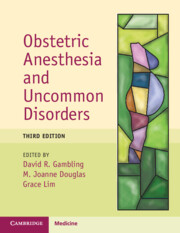Book contents
- Obstetric Anesthesia and Uncommon Disorders
- Obstetric Anesthesia and Uncommon Disorders
- Copyright page
- Cover Illustration
- Epigraph
- Contents
- Preface to Obstetric Anesthesia and Uncommon Disorders, 3rd edition
- Glossary of Common Abbreviations Used in this Text
- Gambling et al.: Obstetric Anesthesia: List of Contributors
- Chapter 1 Obstetric Anesthesia for the Parturient with Complex Medical Diseases
- Chapter 2 Point-of-Care Ultrasound for Obstetrics: Basics and Introductory Chapter
- Chapter 3 FoCUSed Cardiac Ultrasound for Cardiac Disorders
- Chapter 4 Challenging Cardiac Disorders in Pregnancy
- Chapter 5 Uncommon Cardiac Dysrhythmias in Pregnancy
- Chapter 6 Arterial Vascular Diseases
- Chapter 7 Uncommon Respiratory Disorders in Pregnancy
- Chapter 8 Airway Issues
- Chapter 9 Use of Neuraxial Ultrasound for Axial Skeletal Conditions
- Chapter 10 Myopathies and the Parturient
- Chapter 11 Parturients of Short Stature
- Chapter 12 Disorders of the Vertebral Column
- Chapter 13 Miscellaneous Skeletal and Connective Tissue Disorders
- Chapter 14 Disorders of the Central Nervous System in Pregnancy
- Chapter 15 Spinal Cord Disorders
- Chapter 16 Peripheral Neuropathies
- Chapter 17 Disorders of Intermediaries of Metabolism and Malignant Hyperthermia
- Chapter 18 Hepatic Conditions
- Chapter 19 Renal Diseases in Pregnancy
- Chapter 20 Rare Endocrine Disorders
- Chapter 21 Disorders of Blood, Coagulation, and Bone Marrow
- Chapter 22 Infectious Diseases in Pregnancy
- Chapter 23 Dermatologic Conditions in Pregnancy
- Chapter 24 Psychiatric Disorders in Pregnancy
- Chapter 25 Substance Use Disorder
- Chapter 26 Autoimmune Disease
- Chapter 27 Genetic Disorders
- Chapter 28 Anesthesia for Rare Fetal and Placental Conditions
- Index
- Plate Section (PDF Only)
- References
Chapter 21 - Disorders of Blood, Coagulation, and Bone Marrow
Published online by Cambridge University Press: 26 January 2024
- Obstetric Anesthesia and Uncommon Disorders
- Obstetric Anesthesia and Uncommon Disorders
- Copyright page
- Cover Illustration
- Epigraph
- Contents
- Preface to Obstetric Anesthesia and Uncommon Disorders, 3rd edition
- Glossary of Common Abbreviations Used in this Text
- Gambling et al.: Obstetric Anesthesia: List of Contributors
- Chapter 1 Obstetric Anesthesia for the Parturient with Complex Medical Diseases
- Chapter 2 Point-of-Care Ultrasound for Obstetrics: Basics and Introductory Chapter
- Chapter 3 FoCUSed Cardiac Ultrasound for Cardiac Disorders
- Chapter 4 Challenging Cardiac Disorders in Pregnancy
- Chapter 5 Uncommon Cardiac Dysrhythmias in Pregnancy
- Chapter 6 Arterial Vascular Diseases
- Chapter 7 Uncommon Respiratory Disorders in Pregnancy
- Chapter 8 Airway Issues
- Chapter 9 Use of Neuraxial Ultrasound for Axial Skeletal Conditions
- Chapter 10 Myopathies and the Parturient
- Chapter 11 Parturients of Short Stature
- Chapter 12 Disorders of the Vertebral Column
- Chapter 13 Miscellaneous Skeletal and Connective Tissue Disorders
- Chapter 14 Disorders of the Central Nervous System in Pregnancy
- Chapter 15 Spinal Cord Disorders
- Chapter 16 Peripheral Neuropathies
- Chapter 17 Disorders of Intermediaries of Metabolism and Malignant Hyperthermia
- Chapter 18 Hepatic Conditions
- Chapter 19 Renal Diseases in Pregnancy
- Chapter 20 Rare Endocrine Disorders
- Chapter 21 Disorders of Blood, Coagulation, and Bone Marrow
- Chapter 22 Infectious Diseases in Pregnancy
- Chapter 23 Dermatologic Conditions in Pregnancy
- Chapter 24 Psychiatric Disorders in Pregnancy
- Chapter 25 Substance Use Disorder
- Chapter 26 Autoimmune Disease
- Chapter 27 Genetic Disorders
- Chapter 28 Anesthesia for Rare Fetal and Placental Conditions
- Index
- Plate Section (PDF Only)
- References
Summary
Hematological disorders are a heterogeneous group that may be inherited or acquired. During pregnancy the condition may improve, stabilize, or deteriorate due to normal physiological changes. Major risks in women are hemorrhage or thrombosis; inherited conditions may affect fetus as well. A multidisciplinary team is required to manage the pregnancy, delivery, and postpartum. This chapter reviews and summarizes the literature on maternal and fetal outcomes with a focus on anesthetic considerations and publications.
Keywords
- Type
- Chapter
- Information
- Obstetric Anesthesia and Uncommon Disorders , pp. 332 - 366Publisher: Cambridge University PressPrint publication year: 2024

